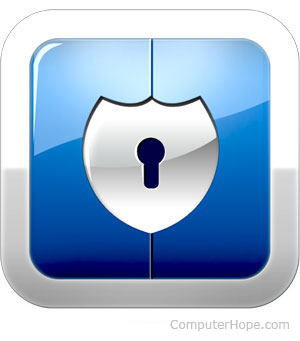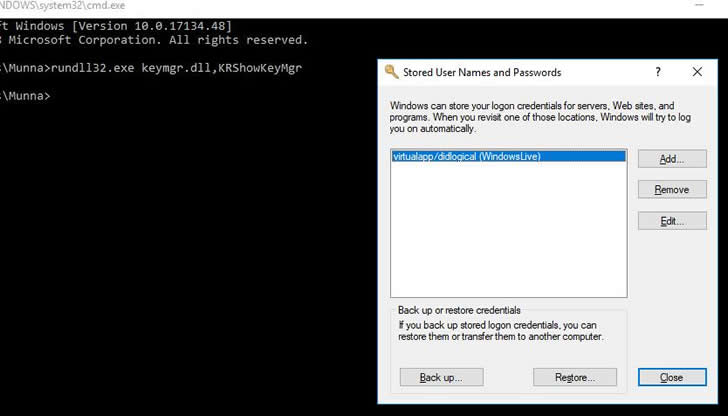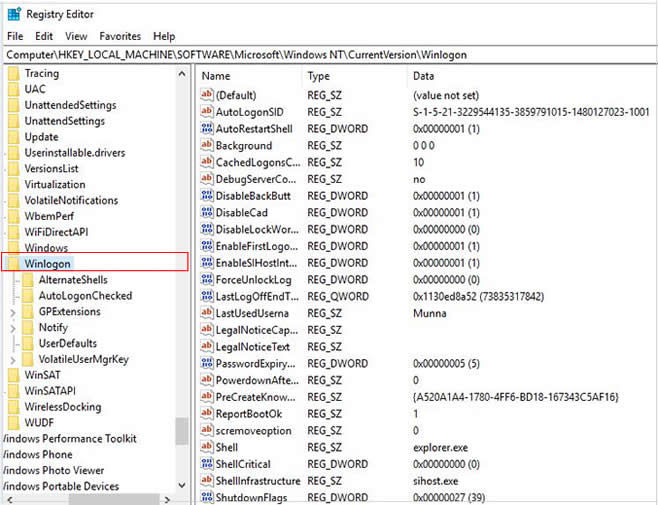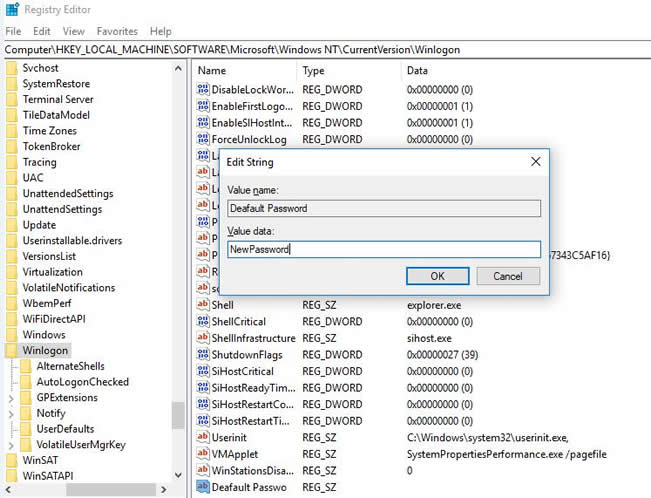- How do I change my username or password?
- Changing the username and password in Windows 10
- Change password
- Change username
- Changing the username and password in Windows 8
- Change password
- Change username
- Changing the username and password in Windows Vista and 7
- Change password
- Change username
- Changing the username and password in Windows XP
- Change password
- Change username
- Changing the username and password in Windows 2000
- Change password
- Change username
- Changing the username and password in Windows 95, 98, and ME
- Change password
- Change username
- Changing the username and password in Apple macOS X
- Change password in macOS X 10.6 or later
- Change password in macOS X 10.3 to 10.5.8
- Change password in macOS X 10.2 to 10.2.8
- Change password in macOS X 10.1.5 or earlier
- Changing the Apple iPad and iPhone passcode
- Change passcode
- Add passcode
- Remove passcode
- Changing the username and password in Linux and Unix and most variants
- Change password
- Change username
- Changing BIOS passwords
- Change password
- Change username
- Changing Internet username and passwords
- Changing online forums and accounts
- Windows user name and password
- Where Are the User or Admin Passwords Stored in Windows 10/8/7
- Method 1: Find My Stored Windows Login Password in Control Panel
- Method 2: Find Your Stored Login or User Password in Registry Editor
How do I change my username or password?
Below are the steps on how to change your username or password in major operating systems, online services, and other locations.
Unless you’re the administrator or root of the system, you need to know the password of the account before it can be changed.
Changing the username and password in Windows 10
Change password
- Press the Windows key , type Sign-in options, and then press Enter .
- In the Password section, click the Change button.
- Verify your account by entering your Microsoft PIN.
- Type in your current password ( A ), choose a new password ( B ), confirm your new password ( C ), and click the Next button ( D ).
Change username
You may only change local accounts names, not Microsoft or administrator account names.
- Press the Windows key , type Control Panel, and then press Enter .
- Select User Accounts.
- Near the middle of the window, click Manage another account.
- Select the account whose name you’d like to change.
- Select Change the account name.
- Choose a new account name ( A ) and then click the Change Name button ( B ).
Changing the username and password in Windows 8
Change password
- Open the Charms menu by pressing the Windows key plus the C key and select Settings.
- In Settings, select Change PC settings.
- In PC Settings, select Users.
- Select the Change your password option to change the password for your local Windows account.
Change username
- From the Windows desktop, open the Charms menu by pressing the Windows key plus the C key and select Settings.
- In Settings, select Control Panel.
- Select User Accounts.
- In the User Accounts window, select Change your account name to change the username for your local Windows account.
Changing the username and password in Windows Vista and 7
Change password
- Open the Control Panel.
- Click Add or remove user accounts.
- Click the account you want to change.
- Click Change the password.
Change username
- Open the Control Panel.
- Click Add or remove user accounts.
- Click the account you want to change.
- Click Change the account name.
Changing the username and password in Windows XP
Change password
- Open the Control Panel.
- Double-click the Users Accountsicon.
- Select the account you want to change.
- Select the option Change my name to change your username or Create a password or Change my password to change your password.
Windows XP Home users can only change the administrator password through Safe Mode.
Change username
- Open the Control Panel.
- Double-click the Users Accountsicon.
- Select the account you want to change.
- Click Change My Name.
- Enter the new name you want to use and click the Change Name button.
Changing the username and password in Windows 2000
Change password
Microsoft Windows 2000 users can change their username by pressing Ctrl + Alt + Del while in Windows to open the Windows Security window. From this window, click the «Change Password» button.
Enter your old password and the new password you want to use.
Change username
To change the username of an account on Windows XP, you need to have an account with administrator rights. If you are logged in as administrator or have an account with administrator rights, follow the steps below.
- Open the Control Panel.
- Double-click the Users and Passwordicon.
- Make sure «Users must enter a user and password to use this computer» is checked.
- Highlight the account you want to change the username for and click the Properties button.
- In Properties, you can change the username.
Changing the username and password in Windows 95, 98, and ME
Change password
To change your password or password settings in Windows 95, 98, or ME, follow the steps below.
The Windows password can also be changed through the Users icon in Control Panel.
Change username
You can change the user settings in Windows 95/98 through the Users icon in Control Panel. However, this does not allow you to change the actual username. If you need to change the username, we suggest you create a copy of your existing username and use the new username. Below are the steps to do this.
- Open the Control Panel.
- Double-click the Usersicon.
- Highlight the user you want to make a copy of and click the Make a copy button.
- Follow the wizard in creating a new user account.
Changing the username and password in Apple macOS X
Change password in macOS X 10.6 or later
- Log in using an administrator account.
- In the Apple menu, select System Preferences.
- In the View menu, select Users & Groups.
- You may need to click the lock button if it appears to be locked. Enter the administrator password.
- Select the user account you want to change.
- Click Reset Password or Change Password.
- In the New Password and Verify fields, type in the new password.
- After entering the new password, click the Reset Password or Change Password button again.
Change password in macOS X 10.3 to 10.5.8
- Log in using an administrator account.
- In the Apple menu, select System Preferences.
- In the View menu, select Accounts.
- You may need to click the lock button if it appears to be locked. Enter the administrator password.
- Select the user account you want to change.
- Click Reset Password or Change Password.
- In the New Password and Verify fields, type in the new password.
- After entering the new password, click the Reset Password or Change Password button again.
- If a dialog window pops up, click OK.
Change password in macOS X 10.2 to 10.2.8
- Log in using an administrator account.
- In the Apple menu, select System Preferences.
- In the View menu, select Accounts.
- You may need to click the lock button if it appears to be locked.
- Select the user account you want to change.
- Select the Edit User option.
- In the New Password and Verify fields, type in the new password and click OK.
- If a dialog window pops up, click OK.
Change password in macOS X 10.1.5 or earlier
- Log in using an administrator account.
- In the Apple menu, select System Preferences.
- In the View menu, select Users.
- You may need to click the lock button if it appears to be locked.
- Select the user account you want to change.
- Select the Edit User option.
- In the New Password and Verify fields, type in the new password and click Save.
Changing the Apple iPad and iPhone passcode
Change passcode
- On the iPad or iPhone, access the Settings utility app.
- On the Settings screen, scroll down and tap Touch ID & Passcode.
- Enter your current passcode.
- On the Touch ID & Passcode screen, tap Change Passcode.
- Enter your current passcode again, then enter your new passcode.
- Enter your new passcode again to confirm.
Add passcode
- On the iPad or iPhone, access the Settings utility app.
- On the Settings screen, scroll down and tap Touch ID & Passcode.
- On the Touch ID & Passcode screen, tap Turn Passcode On.
- Enter a passcode to use when unlocking your device.
- Enter the passcode again to confirm.
- If prompted, enter your Apple ID password.
Remove passcode
- On the iPad or iPhone, access the Settings utility app.
- On the Settings screen, scroll down and tap Touch ID & Passcode.
- Enter your current passcode.
- On the Touch ID & Passcode screen, tap Turn Passcode Off.
- On the Turn Off Passcode? prompt, tap Turn Off.
- If prompted, enter your Apple ID password.
Changing the username and password in Linux and Unix and most variants
Change password
Almost all Linux and Unix operating systems, including variants like Debian, Kali, and Red Hat, have access to the passwd command. Enter this command at the prompt to change your password. You need to know the current password before being able to change the password to a new password.
See the passwd command page for additional information about this command.
Change username
To change the username, you need to have root or super-user access.
To change the username of an account, use the vipw command. See the vipw command page for additional information about this command.
To change the user settings, use the chfn command. See the chfn command page for additional information about this command.
Changing BIOS passwords
Change password
The system password that appears immediately after turning on the computer and BIOS password are both changed through the BIOS setup.
Change username
The computer BIOS does not have a username, only a password.
Changing Internet username and passwords
Changing your Internet username or password is based on your ISP (Internet service provider) and what their policy is for changing the username and password. Often, most ISPs allow you to change your password whenever it’s needed. However, they often do not allow the account username to be changed.
Because every Internet service provider and web host is different, we suggest you contact the company for additional help with changing your username or password.
Changing online forums and accounts
Like the Computer Hope forums, most forums allow the user to change their password only through the profile or account settings. However, most companies do not allow you to change your username. Usually, you must create a new account to do this. If you need additional help with changing your username or password on another website, we suggest you contact the company or webmaster in control of that website.
If you cannot access an online account because you don’t know the username or password, look for a link on the account login page for retrieving a forgotten username or password. This option helps in determining what your username or password is or help in resetting your account password.
Windows user name and password
Where Are the User or Admin Passwords Stored in Windows 10/8/7
If you are using your computer with a system security password to protect it from unnecessary external influences, it is a nice approach indeed to protect your system data, folders and files from unknown invasion. But have you ever wondered as to where these usernames and password get stored within your Windows? I mean there must be certain location within your directory where you can find out the stored Windows credentials. If you are keen enough to know that then this article below is exactly the piece of cake you would wish for.
So basically here in this article we would show you certain pathways to get to those locations where you can actually see the stored usernames and passwords. Most of the time, user confuse Windows credentials with the network and software credentials. Thus they need to keep in mind that the Windows credentials define the user account name and its respective passwords, whereas network credentials define the various remembered passwords of websites you visit via web browsers.
Method 1: Find My Stored Windows Login Password in Control Panel
The first idea that is explained below is the implementation of Control Panel. As you all might know that Control Panel is the seat o f all system and network changes, thus finding the system password within the control panel would be the easiest of all approaches.
Step 1. Type in «Control Panel» in the search box and go to the «User Accounts and Family Safety» option. Then head on to «User Accounts» option.
Step 2. On the left side pane of the Windows, click «Credential Manager». Now you will be presented with two types of credential manager options — «Network Credentials and «Windows Credentials». Since you are here to find out the system username and password, click on «Windows Credentials» and you will be shown the details of username and passwords.
Step 3. You can access the «Stored username and passwords» control panel applet directly by typing certain commands instead of searching from them recklessly in control panel.
Step 4. For that you can press «Windows + R» to open the «Run» dialogue box and then type «cmd» to open the black dialogue box of command prompt. Now type in the following command and hit «Enter»:
rundll32.exe keymgr.dll,KRShowKeyMgr
Step 5. Your stored username and password box will open up instantly where you can clearly see the registered user accounts and their corresponding passwords.
Method 2: Find Your Stored Login or User Password in Registry Editor
Now there is another alternative where you can use the Registry Editor to locate the username and passwords on Windows. For that firstly turn on your computer and from the desktop main screen, press «Windows + R» key combination and type in «regedit» command in the «Run» dialogue box and hit «Enter». Your registry Editor will open up instantly.
Navigate down to the following pathway: HKEY_LOCAL_MACHINE\SOFTWARE\Microsoft\Windows NT\CurrentVersion\Winlogon
Next look out for the «DefaultPassword» sub-key from the list of sub-keys shown on the right-hand side section of the window. Once you get to see the «DefaultPassword» registry key, double click on it and a new little pop up will emerge out. In the «Value Data» field, you will get to see the stored password.
Remember locating the password using Registry Editor is a bit complicated procedure as you have to go through a long string of pathway to find out the location which at times proves to be very complex and confusing. Moreover dealing with registry keys is extremely dangerous as even a slightest mistake can render serious damage to your system. Thus you better keep a backup of your registry keys while handling the Registry Editor and if you are not sure of the technicalities of the registries.
Now the tricks mentioned above are not that difficult to implicate and even a complete novice with computers can easily discern the guideline aforementioned. But still if you find anything too difficult to be handled all by yourself, better not take any risk and seek an expert advice first.
Melissa Parks is a Senior Editor with TunesBro, based in Australia office.В His current focus is on all things tech including iOS, Apple devices, desktop and laptop computers, software and more hands-on guides related iDevice.

















